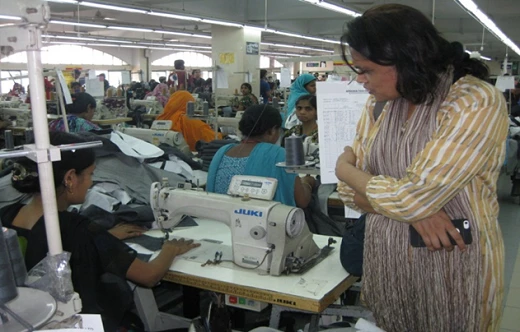Sewing Floor, Armana Apparels, Dhaka. Photo: Shobha Shetty
Contradictory trends in female labor force participation in South Asia continue to pose a puzzle for policymakers. On the one hand, Bangladesh’s ready-made garment industry, one of the mainstays of the national economy, has a high female labor participation rate of 85%. On the other hand, the female labor force participation rates continue to fall in India in spite of recent high economic growth. During my recent visit to Dhaka, I was once again reminded about the enormous challenges of tackling these issues.
I was in Dhaka to attend the 7th Meeting of the BEES (Business, Enterprise and Employment Support for Women in South Asia) Network. Founded in May 2011, the BEES network, facilitated by the World Bank, brings together 15 civil society organisations that work for the economic empowerment of poor women across South Asia. Currently, the network represents women at the bottom of the economic pyramid, with a collective reach of over 100 million. It was a sombre coincidence that the week of our visit marked the first year anniversary of the horrific Rana Plaza disaster in which over 1,100 perished.
The rise of the ready-made garment industry in Bangladesh in the last decade has been stunning by every measure. By 2013, about 4 million people - almost 85% women - were working in the US$22 billion-a-year industry. The industry now contributes to over 75% of Bangladesh’s export earnings and accounts for over 10% of GDP, making it the world's second-largest apparel exporter after China.
But what does it mean for the millions of women employed in this industry? Thanks to Manusher Jonno Foundation (MJF), one of the Bangladesh BEES network members and co-host of the Dhaka meeting, I was lucky to visit the Awaj (“voice”) Foundation to understand this issue better. Founded in 2003, the organisation focuses on empowering female RMG workers. We got an opportunity to meet Nazma Akter, the feisty General Secretary of the foundation and a former garment worker. After spending 7 years in the ready-made garment industry as a young girl, she turned to activism on behalf of her fellow women workers. She is now a well-recognised national name and Awaj has a direct outreach to 60,000 women workers (and 600,000 indirectly).
 “This country has changed so much since Rana Plaza,” muses Nazma. She cites the increase in the recent minimum wage from $38 to $68/month as one example. The labor laws were amended last July to boost worker rights, including the freedom to form trade unions. Nevertheless, the social issues around women’s employment continue to get short shrift and have often been subsumed in other labor issues. “They are treated like sex workers. And they live around factories in such unhealthy environments that their health suffers,” exclaims Nazma. Abysmal living conditions, poor nutrition, lack of maternity benefits, social security, etc. are further exacerbated due to male-dominated top management and unions. Organizations like Awaj and MJF have continued to push strongly for better working conditions and benefits for the women in the ready-made garment industry. Ironically, they are sometimes accused of undermining Bangladesh’s global image and its success in the industry.
“This country has changed so much since Rana Plaza,” muses Nazma. She cites the increase in the recent minimum wage from $38 to $68/month as one example. The labor laws were amended last July to boost worker rights, including the freedom to form trade unions. Nevertheless, the social issues around women’s employment continue to get short shrift and have often been subsumed in other labor issues. “They are treated like sex workers. And they live around factories in such unhealthy environments that their health suffers,” exclaims Nazma. Abysmal living conditions, poor nutrition, lack of maternity benefits, social security, etc. are further exacerbated due to male-dominated top management and unions. Organizations like Awaj and MJF have continued to push strongly for better working conditions and benefits for the women in the ready-made garment industry. Ironically, they are sometimes accused of undermining Bangladesh’s global image and its success in the industry.
In spite of these challenges, Bangladesh is one of the few countries in the region that has seen a rise in female labor force participation in the last decade, partly due to the ready-made garment industry. However, the price has been steep and continuous efforts will be needed to ensure that women’s rights are protected and that employment does not become a double-edged sword.
But, it is a very different picture across the border. According to the recent data, labor force participation rates of women in urban India have dropped to an all-time low of 19% in spite of the economic boom. Even in rural areas, the female labor force participation fell from 49% to 37.3%. Commentators have offered several possible explanations such as measurement issues, discrimination against women in jobs, voluntary withdrawal to focus on caregiving activities, lack of mobility, lack of public safety, regressive social norms, etc.
The South Asia Rural Development & Livelihoods team in the World Bank is researching this issue in-depth in two Indian states with very different labor conditions – Bihar and Tamil Nadu. Our projects operate in some of the poorest areas in these states and primarily work through women’s self-help groups. At their core, these are participatory women’s empowerment and poverty reduction projects. The research teams are using mixed methods to gain a better understanding of some of the reasons behind the declining female labor force participation in these two specific contexts. Detailed qualitative focus group discussions are being supplemented by quantitative analysis of self-help group data. Eventually, we plan to expand this work to Sri Lanka and Pakistan through the BEES network. We strongly believe that our work will offer important insights into the complex and multifaceted world of women’s work in South Asia.
Photo: Nazma Akter, General Secretary, Awaj Foundation in her office in Dhaka.



Join the Conversation